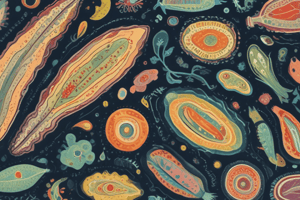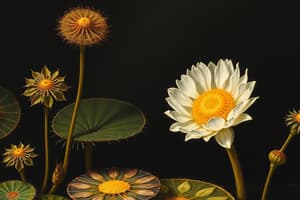Podcast
Questions and Answers
What pigment gives brown algae its color?
What pigment gives brown algae its color?
- Fucoxanthin (correct)
- Phycobilin
- Carotene
- Chlorophyll
All algae are multicellular organisms.
All algae are multicellular organisms.
False (B)
What structure do Paramecium use to move?
What structure do Paramecium use to move?
Cilia
Foraminiferans have porous shells called __________.
Foraminiferans have porous shells called __________.
Match the following clades with their examples:
Match the following clades with their examples:
Which of the following is NOT one of the four main supergroups of protists?
Which of the following is NOT one of the four main supergroups of protists?
All protists are classified as a monophyletic group.
All protists are classified as a monophyletic group.
Name the group that includes all organisms descended from a common ancestor but does not include all common descendants.
Name the group that includes all organisms descended from a common ancestor but does not include all common descendants.
The most diverse group of eukaryotes is known as __________.
The most diverse group of eukaryotes is known as __________.
What is the purpose of measuring the zones of inhibition in bacteriology?
What is the purpose of measuring the zones of inhibition in bacteriology?
Match the descriptions with the corresponding group of organisms:
Match the descriptions with the corresponding group of organisms:
There are currently seven main clades within the four supergroups of protists.
There are currently seven main clades within the four supergroups of protists.
What characteristic does the paraphyletic group of protists specifically exclude?
What characteristic does the paraphyletic group of protists specifically exclude?
What is a distinguishing feature of the Excavata supergroup?
What is a distinguishing feature of the Excavata supergroup?
All members of the Stramenopila clade are autotrophs.
All members of the Stramenopila clade are autotrophs.
Name an example of an organism from the Excavata supergroup.
Name an example of an organism from the Excavata supergroup.
Diatoms generate approximately _______ of Earth’s oxygen annually.
Diatoms generate approximately _______ of Earth’s oxygen annually.
Match the following features with their respective groups:
Match the following features with their respective groups:
Which of the following describes a characteristic of diatoms?
Which of the following describes a characteristic of diatoms?
Diatoms are primarily found in freshwater habitats only.
Diatoms are primarily found in freshwater habitats only.
What type of symmetry does the centric body form of diatoms exhibit?
What type of symmetry does the centric body form of diatoms exhibit?
What type of protists can synthesize their own food through photosynthesis?
What type of protists can synthesize their own food through photosynthesis?
All protists are capable of photosynthesis.
All protists are capable of photosynthesis.
Name one example of a unicellular parasite from the clade Euglenozoa.
Name one example of a unicellular parasite from the clade Euglenozoa.
Slime molds obtain their food by __________.
Slime molds obtain their food by __________.
Match the following protist supergroups with their examples:
Match the following protist supergroups with their examples:
Which of the following statements is true regarding mixotrophs?
Which of the following statements is true regarding mixotrophs?
Forams and radiolarians are examples of the clade Amoebozoans.
Forams and radiolarians are examples of the clade Amoebozoans.
What environments do protists inhabit?
What environments do protists inhabit?
What is a distinguishing feature of Foraminifera?
What is a distinguishing feature of Foraminifera?
Radiolarians have their tests made of calcium carbonate.
Radiolarians have their tests made of calcium carbonate.
What type of nutrition do Foraminifera primarily exhibit?
What type of nutrition do Foraminifera primarily exhibit?
Radiolarians feed on microorganisms through __________.
Radiolarians feed on microorganisms through __________.
Match the following groups with their characteristics:
Match the following groups with their characteristics:
What is the primary mode of nutrition for green algae?
What is the primary mode of nutrition for green algae?
Amoeba has a regular body shape and is multicellular.
Amoeba has a regular body shape and is multicellular.
What are the distinguishing features of Ulva?
What are the distinguishing features of Ulva?
Amoebas move using __________.
Amoebas move using __________.
Match the following algae classifications with their characteristics:
Match the following algae classifications with their characteristics:
Which of the following habitats can green algae be found in?
Which of the following habitats can green algae be found in?
All members of the Archaeplastida clade contain chlorophylls a & b.
All members of the Archaeplastida clade contain chlorophylls a & b.
Green algae have cell walls composed of __________.
Green algae have cell walls composed of __________.
Flashcards
Protists
Protists
The most diverse group of eukaryotes.
Paraphyletic Group
Paraphyletic Group
Includes some but not all organisms descended from a common ancestor.
Monophyletic Group
Monophyletic Group
A group of organisms descended from a common ancestor and includes all of its descendants.
Eukaryotes
Eukaryotes
Signup and view all the flashcards
Supergroups
Supergroups
Signup and view all the flashcards
Clades
Clades
Signup and view all the flashcards
Phylogenetics
Phylogenetics
Signup and view all the flashcards
Protist Taxonomy
Protist Taxonomy
Signup and view all the flashcards
Protist Autotrophs
Protist Autotrophs
Signup and view all the flashcards
Protist Heterotrophs
Protist Heterotrophs
Signup and view all the flashcards
Protist Mixotrophs
Protist Mixotrophs
Signup and view all the flashcards
Trypanosoma
Trypanosoma
Signup and view all the flashcards
Euglenozoa
Euglenozoa
Signup and view all the flashcards
Protist Habitats
Protist Habitats
Signup and view all the flashcards
Protist Reproduction
Protist Reproduction
Signup and view all the flashcards
Sargassum
Sargassum
Signup and view all the flashcards
Cilia
Cilia
Signup and view all the flashcards
Macronucleus
Macronucleus
Signup and view all the flashcards
Micronucleus
Micronucleus
Signup and view all the flashcards
Conjugation
Conjugation
Signup and view all the flashcards
Foram Tests
Foram Tests
Signup and view all the flashcards
Foram Diet
Foram Diet
Signup and view all the flashcards
Radiolaria Shells
Radiolaria Shells
Signup and view all the flashcards
Pseudopodia Function
Pseudopodia Function
Signup and view all the flashcards
Symbiotic Relationship
Symbiotic Relationship
Signup and view all the flashcards
Excavata supergroup
Excavata supergroup
Signup and view all the flashcards
Excavata mode of nutrition
Excavata mode of nutrition
Signup and view all the flashcards
Stramenopila clade
Stramenopila clade
Signup and view all the flashcards
Diatoms
Diatoms
Signup and view all the flashcards
Diatom habitats
Diatom habitats
Signup and view all the flashcards
Diatom symmetry
Diatom symmetry
Signup and view all the flashcards
Diatom test structure
Diatom test structure
Signup and view all the flashcards
Amoeba
Amoeba
Signup and view all the flashcards
Pseudopodia
Pseudopodia
Signup and view all the flashcards
Chlorophyta (Green Algae)
Chlorophyta (Green Algae)
Signup and view all the flashcards
Ulva (Sea Lettuce)
Ulva (Sea Lettuce)
Signup and view all the flashcards
Spirogyra
Spirogyra
Signup and view all the flashcards
Filamentous
Filamentous
Signup and view all the flashcards
Holdfast
Holdfast
Signup and view all the flashcards
Thallus
Thallus
Signup and view all the flashcards
Study Notes
Lab 18: Protists - Overview
- Protists are the most diverse group of eukaryotes.
- They are classified by supergroups and clades.
- Protists employ various life strategies, including autotrophy (photosynthesis), heterotrophy (consuming other organisms), and mixotrophy (both photosynthesis and consuming other organisms).
- Protists inhabit diverse environments, including freshwater, saltwater, and as parasites.
- Protists also employ diverse reproductive strategies: both sexual and asexual reproduction.
Upcoming Activities
- Quiz 4: Covers material from labs 16-18 (November 25)
- Lab Report (Final Draft): Due December 2, 11:59 PM. Students should update their drafts in real-time on Google Drive.
Bacteriology Results - 12.4A and 12.4B
- Students are required to measure zones of inhibition around antibiotic and antiseptic disks on culture plates.
- Measurements should be recorded in lab notebooks.
- Before growth images show bacterial growth while after growth images show no bacterial growth (zone of inhibition).
- The study and analysis of bacteria sensitivity will take place using the zones of inhibition technique
Bacteriology Results - 12.3A and 12.3B
- Using a stereoscopic microscope, analyze bacterial colonies formed on petri dishes
- Determine colony shape (Punctiform, Round, Filamentous, Irregular)
- Characterize colony margins (Smooth, Curled, Wavy, Lobate, Filamentous)
- Evaluate surface features (Smooth, Concentric, Wrinkled, Contoured)
- Assess colony Opacity (opaque, translucent, or transparent) and pigmentation
Phylogenetics
- Monophyletic: A group of organisms that are all descended from a common ancestor and the common ancestor itself.
- Polyphyletic: A group of organisms that do not include the most recent common ancestor.
- Paraphyletic: A group of organisms descended from a common ancestor but does not include all the descendants of that common ancestor
Protist Taxonomy: Supergroups and Clades
- Four main supergroups: Excavata, SAR, Unikonta, Archaeplastida
- These supergroups house seven main clades.
Protist Taxonomy: Clades
- Examples of specific clades and their characteristic features, and the methods for observing them are listed.
Exercise 13.1 : Supergroup Excavata, Clade Euglenozoa
- Trypanosoma: A parasitic unicellular organism found in rat blood, transmitted by fleas.
- Its long, thin structure and undulating membrane facilitate movement through viscous blood.
Specific Examples
- Specific examples of protists, like Trypanosoma, Paramecia, Diatoms, Sargassum (brown algae), forams (with calcium carbonate shells), Radiolarians (with silica shells), Amoeba, Spirogyra, Ulva (sea lettuce), and Rhodophyta (red algae) are described along with key features and methods for observation.
- Images of these specimens under different magnifications (e.g., 100X, 400X) are also present within the slides.
Other Notes
- Students are expected to have labelled sketches of all specimens, and fill out a table for each organism studied in class as a study guide.
Studying That Suits You
Use AI to generate personalized quizzes and flashcards to suit your learning preferences.




